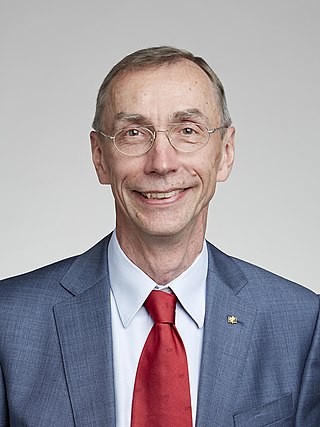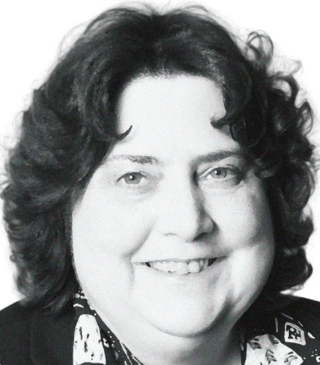
Svante Pääbo is a Swedish geneticist and Nobel Laureate who specialises in the field of evolutionary genetics. As one of the founders of paleogenetics, he has worked extensively on the Neanderthal genome. In 1997, he became founding director of the Department of Genetics at the Max Planck Institute for Evolutionary Anthropology in Leipzig, Germany. Since 1999, he has been an honorary professor at Leipzig University; he currently teaches molecular evolutionary biology at the university. He is also an adjunct professor at Okinawa Institute of Science and Technology, Japan.

FMR1 is a human gene that codes for a protein called fragile X messenger ribonucleoprotein, or FMRP. This protein, most commonly found in the brain, is essential for normal cognitive development and female reproductive function. Mutations of this gene can lead to fragile X syndrome, intellectual disability, premature ovarian failure, autism, Parkinson's disease, developmental delays and other cognitive deficits. The FMR1 premutation is associated with a wide spectrum of clinical phenotypes that affect more than two million people worldwide.
Gerald Mayer Rubin is an American biologist, notable for pioneering the use of transposable P elements in genetics, and for leading the public project to sequence the Drosophila melanogaster genome. Related to his genomics work, Rubin's lab is notable for development of genetic and genomics tools and studies of signal transduction and gene regulation. Rubin also serves as a vice president of the Howard Hughes Medical Institute and executive director of the Janelia Research Campus.

Vindija Cave is an archaeological site associated with Neanderthals and modern humans, located in the municipality of Donja Voća, northern Croatia. Remains of three Neanderthals were selected as the primary sources for the first draft sequence of the Neanderthal genome project in 2010. Additional research was done on the samples and published in 2017.
The multiregional hypothesis, multiregional evolution (MRE), or polycentric hypothesis, is a scientific model that provides an alternative explanation to the more widely accepted "Out of Africa" model of monogenesis for the pattern of human evolution.

Neanderthals, also written as Neandertals, are an extinct species or subspecies of archaic humans who lived in Eurasia until about 40,000 years ago. The type specimen, Neanderthal 1, was found in 1856 in the Neander Valley in present-day Germany.
Genomic structural variation is the variation in structure of an organism's chromosome. It consists of many kinds of variation in the genome of one species, and usually includes microscopic and submicroscopic types, such as deletions, duplications, copy-number variants, insertions, inversions and translocations. Originally, a structure variation affects a sequence length about 1kb to 3Mb, which is larger than SNPs and smaller than chromosome abnormality. However, the operational range of structural variants has widened to include events > 50bp. The definition of structural variation does not imply anything about frequency or phenotypical effects. Many structural variants are associated with genetic diseases, however many are not. Recent research about SVs indicates that SVs are more difficult to detect than SNPs. Approximately 13% of the human genome is defined as structurally variant in the normal population, and there are at least 240 genes that exist as homozygous deletion polymorphisms in human populations, suggesting these genes are dispensable in humans. Rapidly accumulating evidence indicates that structural variations can comprise millions of nucleotides of heterogeneity within every genome, and are likely to make an important contribution to human diversity and disease susceptibility.

Interbreeding between archaic and modern humans occurred during the Middle Paleolithic and early Upper Paleolithic. The interbreeding happened in several independent events that included Neanderthals and Denisovans, as well as several unidentified hominins.
Fragile X-associated Primary Ovarian Insufficiency (FXPOI) is the most common genetic cause of premature ovarian failure in women with a normal karyotype 46, XX. The expansion of a CGG repeat in the 5' untranslated region of the FMR1 gene from the normal range of 5-45 repeats to the premutation range of 55-199 CGGs leads to risk of FXPOI for ovary-bearing individuals. About 1:150-1:200 women in the US population carry a premutation. Women who carry an FMR1 premutation have a roughly 20% risk of being diagnosed with FXPOI, compared to 1% for the general population, and an 8-15% risk of developing the neurogenerative tremor/ataxia disorder (FXTAS). FMR1 premutation women are also at increased risk of having a child with a CGG repeat that is expanded to >200 repeats. Individuals with a full mutation, unlike the premutation, produce little to no mRNA or protein from the FMR1 gene and are affected with Fragile X syndrome.
David Benjamin Goldstein is an American human geneticist. Goldstein is founding Director of the Institute for Genomic Medicine at the Columbia University Medical Center, Professor of Genetics and Development and directs the genomics core of Epi4K and administrative cores of Epi4K with Dan Lowenstein and Sam Berkovic.

Charles Lee is Director and Professor of The Jackson Laboratory for Genomic Medicine, The Robert Alvine Family Endowed Chair and a board certified clinical cytogeneticist who has an active research program in the identification and characterization of structural genomic variants using advanced technology platforms. His laboratory was the first to describe genome-wide structural genomic variants among humans with the subsequent development of two human CNV maps that are now actively used in the diagnoses of array based genetic tests. Lee served as the President of the Human Genome Organisation (HUGO) 2017 to 2023.

Johannes Krause is a German biochemist with a research focus on historical infectious diseases and human evolution. Since 2010, he has been professor of archaeology and paleogenetics at the University of Tübingen. In 2014, Krause was named a founding co-director of the new Max Planck Institute for the Science of Human History in Jena.

Michael Edward "Mike" Goddard is a professorial fellow in animal genetics at the University of Melbourne, Australia.
Robert Anthony Martienssen is a British plant biologist, Howard Hughes Medical Institute–Gordon and Betty Moore Foundation investigator, and professor at Cold Spring Harbor Laboratory, US.

Janet Kelso is a South African computational biologist and Group leader of the Minerva Research Group for Bioinformatics at the Max Planck Institute for Evolutionary Anthropology. She is best known for her work comparing DNA from previous humans with those of the present.
Alice Segers Whittemore is an American epidemiologist and biostatistician who studies the effects of genetics and lifestyle on cancer, after an earlier career as a pure mathematician studying group theory. She works as a professor of health research and policy and of biomedical data science at Stanford University, and has served as president of the International Biometric Society.
Nicholas James Patterson is a mathematician working as a staff scientist at the Broad Institute with notable contributions to the area of computational genomics. His work has appeared in scientific journals such as Nature, Science and Nature Genetics. His research has brought a better understanding of early human migrations. He is among the group of scientists who have sequenced the Neanderthal genome in 2010. This was followed by the sequencing of a much higher quality Neanderthal genome, where the subject was from the Altai Mountains, in 2014. These studies have uncovered some unexpected facts about the interbreeding between archaic and modern humans.
David L. Nelson is an American human geneticist, currently an associate director at the Intellectual and Developmental Disabilities Research Center (1995), and professor at the Department of Molecular and Human Genetics at Baylor College of Medicine BCM since 1999. Since 2018, he is the director at the Cancer and Cell Biology Ph.D program, and the director of Integrative Molecular and Biomedical Sciences Ph.D since 2015 at BCM.

Deborah Ann "Debbie" Nickerson was an American human genomics researcher. She was professor of genome sciences at the University of Washington. Nickerson founded and directed of one of the five clinical sites of the Gregor Consortium and was a major contributor to many genomics projects, including the Human Genome Project and the International HapMap Project.

The 2022 Nobel Prize in Physiology or Medicine was awarded to the Swedish geneticist Svante Pääbo "for his research in the field of genomes of extinct hominins and human evolution". It was announced by Thomas Perlmann, secretary of the Nobel Assembly at Karolinska Institutet in Stockholm, Sweden, on 3 October 2022.









